
Chapter 2: So You Want to Join the World's Grubbiest Club: Internet Entrepreneurs
Revised June 2003

|
Chapter 2: So You Want to Join the World's Grubbiest Club: Internet EntrepreneursRevised June 2003 |
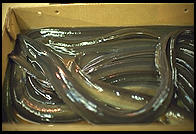 One of the beauties of Web publishing is that it can be free or nearly
free. It can be done in such a way that it need not make money. And
indeed if your site is destined to lose money it is much less
humiliating when you can say that making money wasn't the idea.
Nonetheless there are plenty of folks who've forgotten that greed is one
of the seven deadly sins. This chapter, therefore, is about how to make
money on the Internet.
One of the beauties of Web publishing is that it can be free or nearly
free. It can be done in such a way that it need not make money. And
indeed if your site is destined to lose money it is much less
humiliating when you can say that making money wasn't the idea.
Nonetheless there are plenty of folks who've forgotten that greed is one
of the seven deadly sins. This chapter, therefore, is about how to make
money on the Internet.
First, let's ask anyone thinks that there is money to be made off the Internet. Karl Taylor Compton, former president of MIT, said it best in 1938: "In recent times, modern science has developed to give mankind, for the first time in the history of the human race, a way of securing a more abundant life which does not simply consist in taking away from someone else."
I believe that computers will secure a more abundant life for the human race. This would not have been a controversial statement in 1960, when IBM was just beginning to saturate corporate America with mainframes It was obvious to everyone in 1960 that computers were going to usher in a new Age of Leisure. In 2003, this statement seems absurd. Computers have been around for more than fifty years without having done much for the average person. In fact, it is a commonplace among economists that computers have reduced the productivity of American business.
Computers by themselves are a liability. Getting information into and out of them is so expensive that using paper and file cabinets is probably less trouble. Sure, in 2003 we don't see too many people manually writing payroll checks or calculating artillery shell trajectories. But most people get through most parts of their day without relying on a computer. Why is this unlikely to be true in another 50 years? Because of the network.
 James Watt's 1765 steam engine didn't change your life unless you
were pumping water out of coal mines. A steam-powered factory could have
produced enough goods to supply an entire nation, but since there was no
way to distribute that output there wasn't much point in building such a
factory. With the railroad came the ability to serve a national market
with one factory. Factories grew enormous and pulled people out of the
countryside to work inside the Satanic Mills. It was the mounting of the
steam engine on rails and the spreading of railroads across nations that
transformed society, not the steam engine per se. The computer is
the steam engine of our times; the network is the railroad.
James Watt's 1765 steam engine didn't change your life unless you
were pumping water out of coal mines. A steam-powered factory could have
produced enough goods to supply an entire nation, but since there was no
way to distribute that output there wasn't much point in building such a
factory. With the railroad came the ability to serve a national market
with one factory. Factories grew enormous and pulled people out of the
countryside to work inside the Satanic Mills. It was the mounting of the
steam engine on rails and the spreading of railroads across nations that
transformed society, not the steam engine per se. The computer is
the steam engine of our times; the network is the railroad.
With a ubiquitous network, all of the information that you consume will
arrive in a machine-readable form. If the information is structured
appropriately, as with standards like Electronic Document Interchange
(EDI), it will arrive in a form that is immediately applicable to your
internal databases without human intervention. Your computer will truly
be able to handle routine transactions on your behalf.
 When the network infrastructure is powerful enough for most houses to
enjoy video-rate bandwidth, the computer will be able to support your
collaboration with other people. If you had TV-quality video and audio
links to your collaborators and a shared workspace, you wouldn't have to
commute to work or fly around from city to city so much. Though one does
not like to predict the demise of a 3,000-year-old trend toward
urbanization, it indeed seems possible that collaboration tools might
enable some people to move out to the country yet still keep their urban
jobs. Workers in rich countries would be able to employ assistants in
low-wage countries; imagine a life-size continuosly active video
conferencing system that opened up a wall of your office to a room in
another country.
When the network infrastructure is powerful enough for most houses to
enjoy video-rate bandwidth, the computer will be able to support your
collaboration with other people. If you had TV-quality video and audio
links to your collaborators and a shared workspace, you wouldn't have to
commute to work or fly around from city to city so much. Though one does
not like to predict the demise of a 3,000-year-old trend toward
urbanization, it indeed seems possible that collaboration tools might
enable some people to move out to the country yet still keep their urban
jobs. Workers in rich countries would be able to employ assistants in
low-wage countries; imagine a life-size continuosly active video
conferencing system that opened up a wall of your office to a room in
another country.
The Internet will change society. Some people will get rich off that change. If you want to be one of them the safest bet is perhaps to figure out where all those telecommuters are going to end up living and open a little mall there with a McDonalds, MicroCenter, Starbucks, and Trader Joe's. However, in case we ever see a resurgence of the late 1990s popular obsession with making money from public Web sites, let's start by considering ways to turn hits into revenue.
 The previous chapter divided all Web sites into either "magazine-like
Web Publishing" or "Web-based Application". That is a useful division for
thinking about whether off-the-shelf technology is going to be helpful
to build a site, but when estimating the profit potential of a
consumer-oriented Web site, I think one needs a separate set of four
categories. If you are starting a new site for the purpose of making
money, it is worth considering which categories your planned Web
operations fall into and how hard it is to make money in those
categories.
The previous chapter divided all Web sites into either "magazine-like
Web Publishing" or "Web-based Application". That is a useful division for
thinking about whether off-the-shelf technology is going to be helpful
to build a site, but when estimating the profit potential of a
consumer-oriented Web site, I think one needs a separate set of four
categories. If you are starting a new site for the purpose of making
money, it is worth considering which categories your planned Web
operations fall into and how hard it is to make money in those
categories.
Here are the categories:
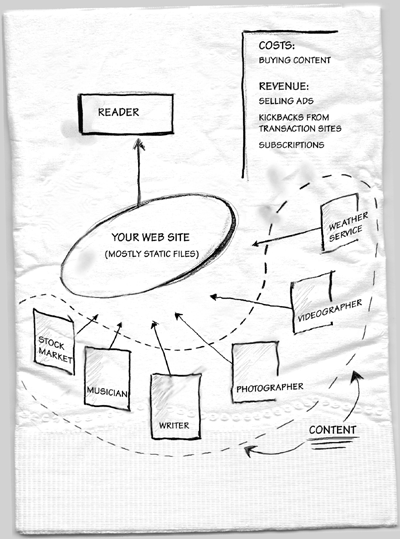
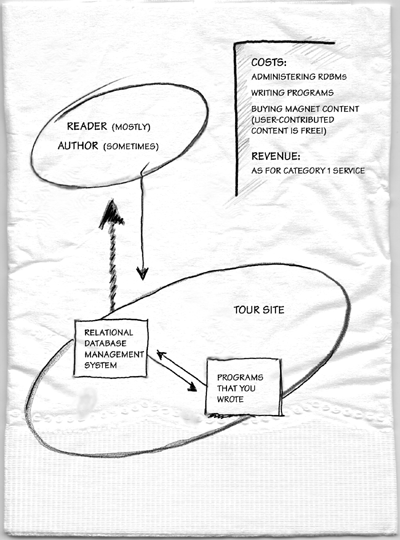
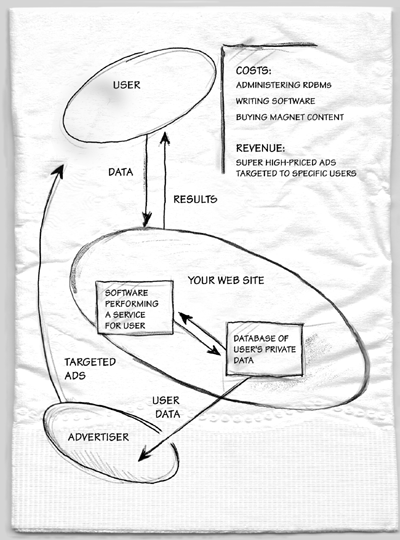
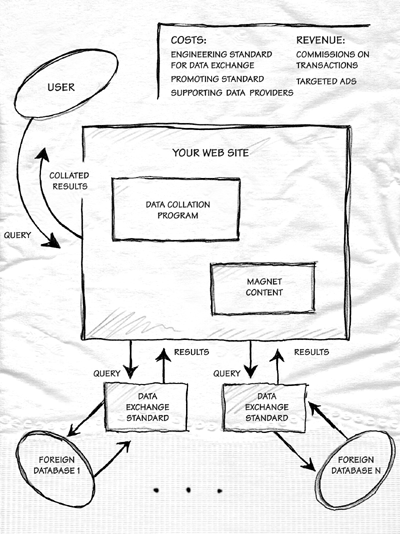
In terms of bang per dollar invested, the most expensive type of site is Category 1. To create a site like this, you have to hire writers, pay photographers and editors, and scrupulously maintain your site. If you stop updating for one day, people may turn away to a competitor's site.
A Category 2 site is very cheap to start up. You spend a little bit of money for programming, a data model, and "anchor content". Thereafter the site expands itself.
A Category 3 site requires much more investment and effort, particularly in selling ads and working with advertisers, but it has potentially much higher payoff since you know so much more about your users. An advertiser won't pay too much for an ad on the MSN home page, perhaps a few cents per impression. All that anyone knows about the readers is that they haven't changed their browser's default first page. An advertiser will pay a lot more for an ad on a search engine's site, if it's delivered only to those people who've entered query words relevant to the product advertised. Small text advertisements in the Google search engine have proven to be the best investment for advertisers on the Internet and quite profitable for Google. A Jerusalem-based programmer can buy an ad that will appear every time someone searches for "Oracle consultant" on the Israeli version of Google. Google doesn't know all that much about its users. A Web application that knew a lot about its reader might be able to charge an advertiser several dollars just to display a single text ad.
Category 4 is probably the most lucrative because it harnesses the full power of the Internet. Entering this area requires having the right connections and making the proper business arrangements. It is the Category 4 sites that will change the way the computer is seen. In a Category 3 car site, you offered users a new car planning service. You know what kinds of car they need, their budgets, and where they live. You can charge car manufacturers and local dealerships quite a bit to display banner ads that might tempt particular users. But in a Category 4 site, you know which user is about to drive to which dealer to buy which car with which options. You can demand a commission from the selling dealer. You can charge $50 to a competing dealership to run an ad that says "Just wait two days and Joe Foobar Toyota will have that same color sedan in stock. The price will be $75 lower and Joe Foobar Toyota is 10 miles closer to your house than the dealer you're planning to buy from."
Let's consider how we'd use these categories to build services for a variety of fields.
 People in rich countries spend a tremendous amount of money on
travel. Vendors and consumers are separated by vast distances and
numerous intermediaries. Each intermediary extracts a commission. It is
the sum total of those commissions that is potentially available to Web
travel sites.
People in rich countries spend a tremendous amount of money on
travel. Vendors and consumers are separated by vast distances and
numerous intermediaries. Each intermediary extracts a commission. It is
the sum total of those commissions that is potentially available to Web
travel sites.
Traditional publishers do their best to capture these commissions with guidebooks, magazines, advertising supplements, and plain old brochures. Despite the vast forests that are chopped down in this valiant attempt, dead trees publishers aren't satisfying travelers. A subscriber opens a travel magazine and finds the articles either much too long, because he or she isn't planning to visit the city described, or much too short, because he or she has a definite trip planned and is hungry for detail. Travel books are better, though they generally suffer from the "one voice" problem and the best-written books usually don't have any pictures because of the expense of color printing can't be justified when there aren't any ads.
Traditional travel publishers don't even try to give consumers the most critical information, e.g., "How did the last 100 people who went there like it?"
An Internet travel site starts off with a huge relevance advantage. Search engines consistently deliver travel URLs to people who are about to book a trip or leave for a destination. No other advertising-carrying medium comes close, except perhaps the airplane and hotel magazines that consumers get after they've started their trip.
The most important Category 1 service for a travel site is magnet content that will attract people to Category 2, 3, and 4 services. You can organize all kinds of Category 2 services around magnet content. For example, suppose that your magnet content in an Italian site says "I went into the cathedral at Assisi to reload my camera; there were some pictures on the walls. I think somebody next to me said they were painted by a guy named ‘Joe'." Somewhere out there on the Net there is a guy who did his art history Ph.D. on those frescoes by Giotto. Your magnet content's function is to draw that expert into surfing your site and contributing a few paragraphs via your comment server.
You will also want to have classified ads for vacation homes and tour packages, Q&A forums, and a quality rating system for tour operators and hotels. What makes all this more useful than rec.travel.europe is that the magnet content gives structure to the user-contributed thoughts.
The obvious Category 3 service for a travel site is a trip planning system. Your database will know where the consumer intends to be at every hour of every day of his trip. With that kind of information about your readers, if you can't sell high-priced ads for delivery to specific people, it won't be my fault!
The obvious Category 4 application is a hotel room booking system. Your server queries all the hotel reservation computers and the consumer can query you: "Show me the available hotel rooms in Paris for September 15th to 20th, sorted by distance from the Louvre and then by price. Oh, and convert the prices to US dollars, please."
It may take the full 50-year horizon of this chapter to come to pass but eventually there will be a usable wireless Internet. When that day comes imagine Joe Traveler, getting tired after a long day of sightseeing, pulling out his cell phone and saying "show me the nearby available hotel rooms for tonight". The phone company knows approximately where you are, based on which tower your handset has connected, and they ought to have enough marketing clout to establish links with hotel chains' room reservations systems.
 Real estate agents in the United States collect a 6 percent commission
every time they connect buyer and seller. This leads to musings like
"Why does New York have so much garbage and Los Angeles so many
real estate agents?" (standard answer: "Because New York had
first choice"). This kind of humor would hurt realtors' feelings if
they weren't raking in $192 billion each year (source: 1997 Census,
probably nearly double that today).
Real estate agents in the United States collect a 6 percent commission
every time they connect buyer and seller. This leads to musings like
"Why does New York have so much garbage and Los Angeles so many
real estate agents?" (standard answer: "Because New York had
first choice"). This kind of humor would hurt realtors' feelings if
they weren't raking in $192 billion each year (source: 1997 Census,
probably nearly double that today).
Realtors are precisely the sorts of intermediaries that Internet technology was supposed to eliminate. Suppose that these folks were not operating their own realtor.com site. If you were trying to capture a share of this $192 billion, you'd want to start in Category 1 with articles about moving or character sketches for neighborhoods. This content would attract search engine users. Moving into Category 2, you'd run a commission-based classified ad system to connect renters with landlords and buyers with sellers. For a Category 3 service, perhaps you could create a moving planner. You'd get the old address, the new address, and the moving date from the user. You could use that data to help the user find a household mover, disconnect and hook up utilities, compute cost-of-living differences, and arrange personal travel. Meanwhile, you'd be bombarding the person with ads from competing communications, furniture, and appliance vendors in the new locale. For a Category 4 application you'd cut deals with other real estate sites to query their databases. If a user made a transaction on that foreign site, you'd split the commissions. Meanwhile, back in the real world the realtors have a monopoly on the Multiple Listing Service, the canonical database of houses for sale, and realtor.com is the only Web interface to it. Still, you can see that realtor.com incorporates many of the elements of our abstract plan.
 Joe Schmoe is treated at five different hospitals over a 3-year
period. Each hospital has a sophisticated computer medical record
system. When Mr. Schmoe visits hospital number 6, the clerks create a
record for him on their big database. But even though Joe's
entire medical record is available in electronic form, the new hospital
has no way to import it from the previous five hospitals. So the doctors
don't realize that Joe is allergic to an obscure drug. Joe dies.
Joe Schmoe is treated at five different hospitals over a 3-year
period. Each hospital has a sophisticated computer medical record
system. When Mr. Schmoe visits hospital number 6, the clerks create a
record for him on their big database. But even though Joe's
entire medical record is available in electronic form, the new hospital
has no way to import it from the previous five hospitals. So the doctors
don't realize that Joe is allergic to an obscure drug. Joe dies.
You could have saved Joe's life. You could have built a Web site where Joe can store and control his own medical record. When he goes to a new hospital, he can authorize the staff to retrieve portions of his old record and to store their findings back on his personal server. Then when Joe has an accident while traveling and is rushed to a Parisian hospital, the doctors there can download his record and find out just which drugs will provoke a life-threatening allergic reaction.
This is a Category 4 site with a vengeance. All of the challenge is in figuring out how to make disparate databases talk to each other. The data models on the hospital systems can be radically different. Even trivial differences, such as different abbreviations for the same disease, can prevent databases from understanding each other. You have to find a way to get these databases to cooperate even though they were never designed to do that.
Big companies do this all the time, of course. They'll decide that starting July 1, everyone is moving to the big new central database system and everyone will use the same part number for a number 8 machine screw. They have the money, resources, and authority to make this happen. On the Internet, there are many more organizations who could benefit from data exchange, but there is much less trust, less money, and no central authority. This creates a huge technical challenge to figure out a cheap automated or semi-automated method of integrating databases (see the last chapter of this book).
That's a whirlwind tour of the four ways to break down consumer Web services. Assuming you run with one of my ideas or come up with a great one of your own, then you'll be on your way to achieving the Holy Grail of the Web: traffic.
 After all the dust settled from the Great Internet Gold Rush of the
1990s, what kinds of businesses turned out to be profitable? Curiously
the answers turned out to be Internet gateways to existing computer
systems and online communites.
After all the dust settled from the Great Internet Gold Rush of the
1990s, what kinds of businesses turned out to be profitable? Curiously
the answers turned out to be Internet gateways to existing computer
systems and online communites.
Airline reservations systems were already centralized in big computers going back as far as the 1960s. Adding a Web interface to those computers turned into profitable businesses for Expedia, Orbitz, and Travelocity.
The unexpected achievers turned out to be online communities. Nearly every ecommerce dotcom failed yet Amazon succeeded. To understand why, imagine if a new store opened up across the street from your house. It appeared well-stocked and clean but after a month you'd never seen anyone go in. Would you be willing to shop there? The typical business-to-consumer ecommerce site was the online analog of this offline situation. A venture capital firm would put up $100 million. The site would launch with fancy graphics and an impressive-sounding product catalog. But each person who looked at a page from the shop would be, as far as he or she knew, the only person who had ever looked at that page. At Amazon, by contrast, a product page would also contain 10 reader reviews. You could assume therefore that at least 10 people had purchased that book from Amazon, received it in the mail, and were able to read it. Amazon is an online community of consumers where as it happens you can buy stuff. In June 2003 Amazon has a market capitalization of $14 billion and nearly all of the people who tried to sell without the community angle are bankrupt.
America Online made money with a combination of connectivity and community, taking in roughly $9 billion in revenue for 2002. Yahoo Finance describes eBay Inc. as "a Web-based community in which buyers and sellers are brought together to browse, buy and sell items online..." and lists its annual sales as 1.45 billion of which nearly one third was profit.
>It may take the full 50-year horizon of this chapter to come to pass but eventually there will be a usable wireless Internet. When that day comes imagine Joe Traveler, getting tired after a long day of sightseeing, pulling out his cell phone and saying "show me the nearby available hotel rooms for tonight". The phone company knows approximately where you are, based on which tower your handset has connected, and they ought to have enough marketing clout to establish links with hotel chains' room reservations systems.This is very nearly here in europe as I write this - for example, already (January 2004) I can ask my phone what time the next train (or last train, or whatever or time) will be from the station nearest me to anywhere else. It will also give me live running info for a large part of the rail network.
-- Nickoli Wilde, January 21, 2004
Mr. Nickoli Wilde does have a point in the fact that 50 years are to much. Though everybody knows that the internet is not such a common thing in Romania, themobile internet(WAP) is a preety common way of getting information on the road. The only problem is that you will find verry little merchants willing to invest anything in taking their business on the web.(In fact I do not think there are any)
-- Victor Tanvuia, April 30, 2005
You don't list a subscription fee as a way of making money from the application site. I would have expected this to have been mentioned and then examples of why this did not work, or where it does work. One examle of this is http://www.myGoals.com . I don't know if they are profitable, but it is fee based.I particularly thought your take on the "community" was valid. A basic retail site like Amazon, or Netflix shows the power of community.
Thanks
-- Tom Pax, January 5, 2007